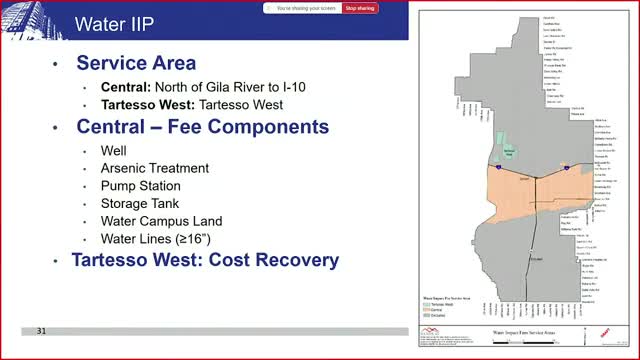New impact fees could double costs for developers
August 07, 2024 | Buckeye, Maricopa County, Arizona

This article was created by AI summarizing key points discussed. AI makes mistakes, so for full details and context, please refer to the video of the full meeting. Please report any errors so we can fix them. Report an error »

In a recent government meeting, officials discussed significant changes to water and wastewater impact fees for new developments in the region. The proposed fee structure aims to address the rising costs associated with infrastructure development as the area experiences growth in both residential and commercial sectors.
The meeting highlighted two primary service areas: Central and Tartesso West. For Central, the proposed water impact fee is set at $22.56 per gallon, reflecting a substantial increase due to construction costs over the past five years. This fee will be applicable to new developments, with the expectation that builders will pass these costs onto homebuyers. In contrast, Tartesso West will continue to operate under a cost recovery model for existing infrastructure, which will phase out once the area reaches capacity.
Officials noted that the fee structure is designed to ensure that new developments contribute fairly to the costs of expanding water and sewer infrastructure. Developers opting to build their own infrastructure may receive credits against these fees, promoting cost-effective solutions.
The discussion also covered wastewater services, with fees varying between service areas. Central is expected to see a more significant increase compared to Sundance, where existing services are less extensive. The proposed changes aim to align fees with the actual costs of providing services, ensuring that the city can maintain its level of service as new developments arise.
Overall, the proposed impact fees for single-family residential units could rise by 117%, from approximately $16,295 to $35,386. This increase positions the city at the higher end of the fee spectrum compared to neighboring municipalities. Multifamily and commercial developments are also expected to see substantial fee increases, with multifamily units projected to pay about 75% of what single-family homes would pay, reflecting their lower water usage.
The meeting underscored the importance of these adjustments in managing the growing demand for water and wastewater services, ensuring that the infrastructure can support future development while maintaining service quality for existing residents.
The meeting highlighted two primary service areas: Central and Tartesso West. For Central, the proposed water impact fee is set at $22.56 per gallon, reflecting a substantial increase due to construction costs over the past five years. This fee will be applicable to new developments, with the expectation that builders will pass these costs onto homebuyers. In contrast, Tartesso West will continue to operate under a cost recovery model for existing infrastructure, which will phase out once the area reaches capacity.
Officials noted that the fee structure is designed to ensure that new developments contribute fairly to the costs of expanding water and sewer infrastructure. Developers opting to build their own infrastructure may receive credits against these fees, promoting cost-effective solutions.
The discussion also covered wastewater services, with fees varying between service areas. Central is expected to see a more significant increase compared to Sundance, where existing services are less extensive. The proposed changes aim to align fees with the actual costs of providing services, ensuring that the city can maintain its level of service as new developments arise.
Overall, the proposed impact fees for single-family residential units could rise by 117%, from approximately $16,295 to $35,386. This increase positions the city at the higher end of the fee spectrum compared to neighboring municipalities. Multifamily and commercial developments are also expected to see substantial fee increases, with multifamily units projected to pay about 75% of what single-family homes would pay, reflecting their lower water usage.
The meeting underscored the importance of these adjustments in managing the growing demand for water and wastewater services, ensuring that the infrastructure can support future development while maintaining service quality for existing residents.
View full meeting
This article is based on a recent meeting—watch the full video and explore the complete transcript for deeper insights into the discussion.
View full meeting
